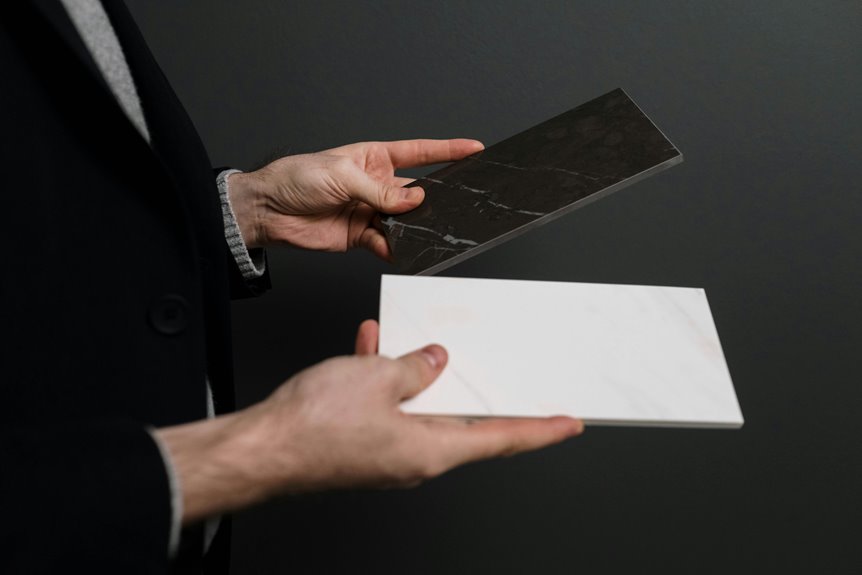You might not realize that both ramie and linen come from the same family of plants called bast fibers, yet their breathability and texture differ more than you’d expect. If you’ve ever wondered how these differences affect comfort, care, and style, there’s a lot to uncover. Understanding these nuances can change how you choose fabrics for warm weather, but it’s not just about feel—there’s more beneath the surface that sets them apart.
Table of Contents
Key Takeaways
- Linen is slightly more breathable than ramie due to its natural fiber structure, enhancing comfort in warm weather.
- Both ramie and linen offer moisture-wicking and temperature regulation properties, aiding in all-day wearability.
- Ramie feels stiffer initially but softens with washing, while linen feels crisper and more breathable from the start.
- Proper care includes gentle cold water washing and air drying to maintain breathability and fabric integrity for both fibers.
- Linen’s lighter, flowing drape supports better airflow, whereas ramie’s denser weave provides a firmer, less airy feel.
Botanical Origins and Production Regions
Although both ramie and linen come from natural plant fibers, they originate from different species and grow in distinct regions.
When you look at ramie cultivation, you’ll find it primarily thrives in East Asia, especially China, where the plant is prized for its fast growth and high fiber yield. Ramie plants prefer warm, humid environments, and farmers carefully harvest the stalks to extract the fibers.
On the other hand, linen harvesting revolves around flax, which grows best in cooler climates like those in Europe and parts of North America.
You’ll notice that flax requires a specific growing season, often planted in early spring and harvested before flowering to guarantee the strongest fibers.
Understanding these differences helps you appreciate how regional climates influence ramie cultivation and linen harvesting practices.
Texture, Feel, and Fabric Characteristics
When you touch ramie and linen, you’ll notice their unique textures and natural sheen.
Each fabric has a distinct weight that affects how it drapes on your body.
Understanding their initial feel and softness helps you choose the right fabric for your needs.
Texture and Sheen
Because texture and sheen greatly influence how a fabric feels and looks, understanding these qualities in ramie and linen helps you choose the right material for your needs.
Both fibers offer distinct texture variations and sheen levels that set them apart.
- Ramie has a crisp texture with a natural luster, giving it a subtle shine that enhances its elegant appearance.
- Linen’s texture is more varied, ranging from smooth to slightly rough, with a matte finish that feels soft against your skin.
- Over time, ramie maintains its sheen better, while linen develops a charming, lived-in softness but loses some shine.
Fabric Weight and Draping
The way ramie and linen handle weight and draping shapes how they move and feel on your body. Ramie tends to have a higher fabric density, giving it a stiffer draping quality, while linen is lighter and flows more naturally. This means ramie holds shape better but may feel less fluid, whereas linen’s airy drape offers relaxed elegance. Understanding these traits helps you choose the right fabric for your style and comfort.
| Fabric Type | Fabric Density | Draping Quality |
|---|---|---|
| Ramie | Higher | Firmer, structured |
| Linen | Lower | Soft, flowing |
With this in mind, you’ll appreciate how each fiber complements different garment designs and occasions.
Initial Feel and Softness
Texture plays a big role in how you experience ramie and linen right from the start.
When considering the initial feel and softness comparison, you’ll notice distinct differences that impact comfort and preference. Here’s what to expect:
- Ramie feels slightly stiffer initially due to its natural fiber structure but softens with washing.
- Linen offers a crisper, cool touch right away, often perceived as more breathable.
- Both fibers have a textured surface, but linen tends to feel smoother against the skin after repeated use.
Your choice depends on whether you prioritize immediate softness or a fabric that improves over time.
Understanding these nuances helps you select between ramie and linen based on how each fabric feels the moment you put it on and how it adapts to your skin.
Breathability, Comfort, and Care Tips
Although both ramie and linen offer excellent breathability, you’ll find subtle differences in how they feel against your skin and how you should care for them.
Both ramie and linen are breathable, with subtle differences in feel and care requirements.
In a breathability comparison, linen tends to be slightly more breathable due to its natural fiber structure, making it ideal for hot, humid days. Ramie, while breathable, feels a bit stiffer initially but softens with wear. Comfort factors like moisture-wicking and temperature regulation favor both fibers, but linen edges out slightly for all-day wear.
When caring for these fabrics, you should wash them gently in cold water to preserve their texture. Avoid high heat drying; air drying helps maintain softness.
Iron linen while damp, but ramie benefits from a lower temperature to prevent damage. Proper care keeps both fabrics comfortable and breathable longer.
Environmental Impact and Sustainability
Beyond how ramie and linen feel and care for, you’ll want to contemplate their impact on the environment.
Both fibers come from plants and are considered eco friendly materials, but their sustainability varies. When choosing between them, keep these 3 points in mind:
- Water Usage: Linen (flax) requires less water than ramie, making it a more sustainable choice in water-scarce regions.
- Chemical Use: Ramie often needs more chemical processing to extract fibers, while linen typically involves fewer chemicals through sustainable practices.
- Biodegradability: Both fibers naturally biodegrade, but linen’s cultivation demands less intensive resources overall.
Style, Color, and Fashion Applications
How do ramie and linen differ when it comes to style and color?
Ramie offers a silky sheen and smooth texture, making it perfect if you want a polished look that holds vibrant color well.
Ramie’s silky sheen and smooth texture create a polished look that beautifully retains vibrant colors.
Linen, on the other hand, has a more matte finish with natural creases, giving your outfits a relaxed, timeless vibe.
When following current color trends, ramie’s ability to absorb rich dyes means your fashion pairings can be bold and eye-catching.
Linen suits softer, earth-toned palettes, complementing casual and layered styles effortlessly.
You’ll find ramie in trendy, structured garments, while linen shines in breathable, everyday wear.
Understanding these differences helps you choose fibers that enhance your wardrobe’s versatility and align with your personal style.
Production Costs and Market Demand
When choosing between ramie and linen for your wardrobe, it’s also helpful to evaluate their production costs and market demand. Understanding these factors can guide your buying decisions effectively.
- Production Costs: Ramie tends to have lower production costs because it requires less water and fewer pesticides. Linen, derived from flax, involves more labor-intensive processing, making it pricier.
- Market Demand: Linen enjoys higher market demand due to its long-standing reputation and versatility in fashion. Ramie is gaining traction but remains more niche.
- Price Impact: Because of these dynamics, linen products often carry a higher price tag, while ramie offers a budget-friendly alternative without sacrificing breathability.
Frequently Asked Questions
Can Ramie Fabric Be Easily Dyed at Home?
Dyeing ramie fabric at home paints your world with vibrant hues. You’ll find ramie dyeing techniques simple, using common home dyeing materials. Just prep well, and your fabric will soak colors like a thirsty canvas.
How Do Ramie and Linen Perform in Moisture-Wicking?
You’ll find ramie has excellent moisture absorption but dries slower, while linen wicks moisture efficiently and dries faster. So, if quick drying matters, you’ll prefer linen; otherwise, ramie handles moisture well too.
Are Ramie and Linen Hypoallergenic for Sensitive Skin?
You’ll appreciate ramie properties that make it gentle on sensitive skin, while linen benefits include natural hypoallergenic qualities. Both fibers reduce irritation, so you can comfortably wear them without worrying about allergic reactions or discomfort.
What Types of Sewing Needles Work Best With Ramie?
You’ll want to use sharp, universal ramie needle types, like size 70/10 or 80/12, for smooth sewing. Adjust your sewing techniques by slowing down to avoid fabric damage and guarantee precise, clean stitches.
Can Ramie and Linen Be Blended With Synthetic Fibers?
You can blend ramie and linen with synthetic fibers using advanced blending techniques. Their synthetic compatibility enhances durability and stretch, letting you create fabrics that combine natural breathability with performance benefits for versatile, comfortable textiles.
- The Difference Between Suzani and Ikat Fabric - June 28, 2025
- What Is Pochampally Ikat? a Journey to India’s Silk City - June 28, 2025
- What Is Pochampally Ikat? a Journey to India’s Silk City - June 27, 2025





